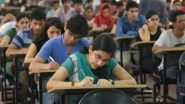New Delhi [India], Nov 14 (ANI): With each passing day, the air quality of the national capital and its adjoining areas such as Gurugram, Faridabad, Ghaziabad, and Noida continues to deteriorate making it tough for the residents, especially children, to go outdoors.Some school children said that their studies were being affected by the closure of schools."Not only health but also our studies are being affected. There is so much smog in the area. Accidents are also occurring because of low visibility on the roads. People are forced to wear masks to protect themselves," Tanu, a school student, told ANI.Lakshmi, another school student, said, "I feel suffocated the moment I step out of my house. There is no fresh air. We are forced to stay indoors nowadays. Sometimes I also get breathless while I am out of my home."On Thursday, the Air Quality Index (AQI) docked at 472 with particulate matter (PM) 2.5 levels at 322 and PM 10 levels at 487 at 8:30 in the morning, said System of Air Quality and Weather Forecasting And Research (SAFAR).An AQI between 201 and 300 is considered 'poor', 301-400 'very poor' and 401-500 'severe'. An AQI above 500 falls in the 'severe plus' category.As air pollution levels are nearing 'severe plus category', schools in Noida, Ghaziabad and Delhi have been shut for two days, hours after the apex court-mandated anti-pollution authority EPCA yesterday they should be closed as pollution in the region hovered close to 'emergency' levels.Children and infants are more susceptible than adults to air pollution as they still developing and their respiratory tracks are more permeable.According to the UNICEF study, 2016, 'Clean the air for children', around 300 million children around the world currently live in areas where the air is toxic - exceeding international limits by at least six times.Using satellite imagery of outdoor air pollution, this study found that around 300 million children currently live in areas where outdoor air pollution exceeds international guidelines by at least six times.The study said in total, around 2 billion children live in areas that exceed the World Health Organization annual limit of 10 mg/m3 (the amount of micrograms of ultra-fine particulate matter per cubic metre of air that constitutes a long term hazard). (ANI)
(The above story is verified and authored by ANI staff, ANI is South Asia's leading multimedia news agency with over 100 bureaus in India, South Asia and across the globe. ANI brings the latest news on Politics and Current Affairs in India & around the World, Sports, Health, Fitness, Entertainment, & News. The views appearing in the above post do not reflect the opinions of LatestLY)













 Quickly
Quickly


